
What’s Blue Light, and How Does It Affect Our Eyes?
With our increasing reliance on digital devices, many people are concerned about blue light and its potential effects on our eyes and health. While blue light comes naturally from the sun, it’s also emitted by LED lights and electronic screens. Some experts warn that artificial blue light could be harmful to our eyes, but research remains inconclusive. Here’s an in-depth look at what blue light is, how it impacts our eyes, its risks and benefits, and how to reduce exposure.
What is Blue Light?
Blue light is a segment of the visible light spectrum, known for its high-energy, short wavelengths. Here’s a quick overview of the electromagnetic spectrum:
- Longer waves: Radio waves, microwaves, infrared
- Shorter waves: X-rays, gamma rays
Blue light occupies the portion of the visible light spectrum between approximately 380 to 500 nanometres and sits right next to ultraviolet (UV) light, which is known to have harmful effects with overexposure.
Is Blue Light Harmful to Your Eyes?
Concerns have emerged about blue light exposure, particularly from artificial sources such as LED screens. Here’s a quick overview of how blue light may affect eye health:
- Natural vs. Artificial Sources: Although the sun is the primary source of blue light, digital devices emit additional blue light, increasing our cumulative exposure and potentially contributing to eyestrain.
- Impact on Retinal Health: Animal studies suggest that blue light may damage retinal cells, but there is no strong evidence of digital blue light causing long-term harm to the human retina.
Note: While the effects of blue light on eye health remain debated, some researchers believe it can contribute to discomfort and eyestrain.
Risks and Side Effects of Blue Light Exposure
While blue light from digital devices is unlikely to cause serious harm, there are some associated risks and side effects to consider:
1. Macular Degeneration
Age-related macular degeneration (AMD) is the primary cause of vision loss in those over 50. Some studies have raised questions about whether blue light accelerates this condition, but no concrete evidence links digital blue light exposure to AMD.
2. Digital Eyestrain
Extended use of digital screens at close range can lead to digital eyestrain, which is characterised by symptoms such as:
- Dry or irritated eyes
- Facial muscle fatigue
- Blurred vision
- Headaches
Blue light scatters more easily than other colours, making it more difficult for the eye to focus, which may increase strain.
3. Sleep Disruption
Blue light exposure, particularly at night, can interfere with sleep by reducing melatonin production. This can lead to disturbances in the sleep-wake cycle and contribute to various health issues, such as:
- Higher risk of hormone-related cancers
- Changes in blood sugar levels
Benefits of Blue Light
Interestingly, blue light also has some health benefits:
1. Enhanced Alertness
Blue light can improve alertness and cognitive performance during the day, especially in the early morning or afternoon.
2. Improved Mood
Blue light therapy is often used to treat Seasonal Affective Disorder (SAD), a type of depression that typically occurs during the darker winter months. Research has also shown that it can benefit those with non-seasonal depression when combined with other treatments.
3. Better Skin Health
Blue light can be used to treat skin conditions like acne and actinic keratosis. It’s best to consult a dermatologist before using any at-home blue light treatments, to ensure safe and effective usage.
How to Limit Blue Light Exposure
Minimising blue light exposure, especially at night, can help reduce eyestrain and improve sleep. Here are a few ways to do this effectively:
1. Use Blue-Light-Blocking Glasses
Blue-light-blocking glasses can filter out a portion of blue light from digital devices. Wearing these glasses when using screens may help to alleviate eye discomfort and reduce sleep disruption. You can find these glasses in various designs, and some are specifically made for evening use.
2. Follow the 20/20/20 Rule
The 20/20/20 rule is a simple but effective strategy for reducing eyestrain. Every 20 minutes, take a 20-second break to focus on an object at least 20 feet away. This allows your eyes to rest and refocus, which can help reduce digital eyestrain.
3. Use Artificial Tears
When using screens, people tend to blink less often, which can lead to dry eyes. Artificial tears or even a humidifier can help maintain moisture in your eyes and prevent irritation.
4. Adjust Your Screen Settings
Many devices now include “night mode” or “blue light filter” options, which can change the screen’s colour to warmer tones. Enabling this feature in the evening can help you sleep better by reducing blue light exposure.
Conclusion
Blue light is a natural part of the electromagnetic spectrum, and we’re exposed to it daily through the sun and artificial sources like LED screens. While digital blue light is not proven to cause severe eye damage, it can contribute to eyestrain and disrupt sleep cycles.
Managing your screen time, using blue-light-blocking glasses, and taking breaks are effective strategies for reducing exposure. Remember to give your eyes the rest they need and adjust your digital habits, especially if you use devices in the hours before bedtime.



